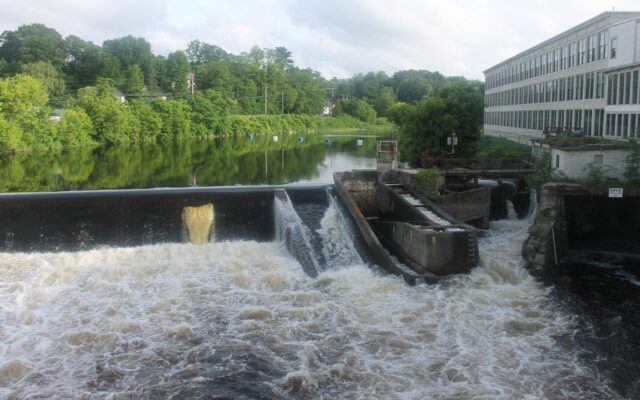
Dover-Foxcroft committee wants to replace town’s iconic dam with a park
DOVER-FOXCROFT — A committee responsible for finding a solution to Dover-Foxcroft’s deteriorating dam and connected facilities wants to remove them and build a riverfront park.
The town partnered with three groups in 2022 to study the Mayo Mill dam and plan for its future. The Atlantic Salmon Federation, Nature Conservancy in Maine and Inter-Fluve looked at how to make the dam compliant with state and federal regulations and improve fish passage.
The town acquired the dam on the mainstem of the Piscataquis River in downtown Dover-Foxcroft in 2007. The 12-foot-high, 150-foot-long concrete structure is aging and faces challenges, including fish migration and long-term maintenance and operations costs.
The dam carries deep history in Dover-Foxcroft, the largest town in Piscataquis County, but it has not operated for more than a decade. Removing the structure and landscaping, estimated to cost $20 million, would bring more green space to the downtown. But the steering committee recommending the idea feels the project is in the town’s best interests moving forward, according to its report.
Reducing flooding dangers, improving the area’s ecology including fish passage and the availability of funding for dam removal were among the reasons listed in the report.
“In the end, returning the Piscataquis River to its natural, free-flowing state, and working to create a riverfront park as part of downtown revitalization efforts, was seen as the best solution for the community,” the committee wrote in its recommendation, dated Jan. 4.
Over the years, the town consulted with engineers, turbine suppliers and a private developer to find a way to use the hydropower again, but it determined that none of the options are economically viable, according to the project’s website.
A steering committee, composed of three local select board members and three others, was charged with considering the study’s findings for the mill and powerhouse.
Those involved in the research considered how to make fish passage more effective, public safety, public amenities downtown and costs for construction, among other elements.
The study, which the salmon federation funded, proposed five viable options from the original list of 23 presented to the committee this past July. Those were then narrowed to two options, with one calling for removal of the dam and powerhouse and the other for dam replacement, plus the installation of a nature-like fishway. The structure is designed to simulate natural river channels and improve fish passage.
The committee generally agreed that the original purpose of the dam for hydroelectric generation was no longer viable, according to its report.
“Support for maintaining at least some of the impoundment was voiced by several steering committee members, since that view of the river is what Dover-Foxcroft residents have known for over a century,” the group wrote.
Project coordinator Alsina Brenenstuhl recalls the November meeting when the committee finalized its recommendation as emotional for some in attendance. Many of those involved in the process did not anticipate removing the dam as being the best option given its extensive history in town, but that is where the information pointed them, she said.
Committee members visited Walton’s Mill Park in Farmington, where the dam was removed and replaced with a park, to get an idea of what such an approach could look like, Brenenstuhl said. They also visited a project to provide a natural fish bypass for the dam in Howland.
The committee will collect feedback from the public during a meeting at 6 p.m. Jan. 25, at Central Hall Commons in Dover-Foxcroft. Members are expected to bring the proposal to the Dover-Foxcroft Select Board next month.